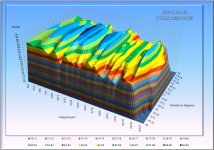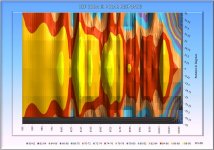In the first scenario, we have a seven inch full range in a box, with no diffraction treatment. In this scenario, we have a minimum of five drivers:
The seven inch full range, which acts like an array of smaller transducers with a specific cone shape.
Four duplicates of the original signal, created at the left, right and top edge of the cabinet.
A duplicate at the floor.
Ok but how is what you describe a line array? Also I don't see corner edge difraction as mirrors like a floor reflection would be. They are also not in line, the location depending instead on your baffle size. You are going to get comb filtering from them but I don't see how you could consider them discrete and identicle sound sources as you would drivers in a line array?
You got me baffled
Rob
So we still don't know where the Summa's far field begins. Maybe Earl has data on that? He already showed so much pretty colorful and detailed data in his paper that the other (bad) boys don't show
I don't see any significant variation after about 2 meters. But up to that distance its quite variable.
Have any theories on why it works?
The question is why it should not work. We're moving our head only for ambiguous listening cues, e.g. sounds coming from the median plane. Stereo or multichannel places discreet sound sources mostly on the frontal horizontal plane at angles less than 60° from the center where our localization abilities are best. So as long as you hear through your own ears (= personalized HRTFs) ambiguous listening cues will be the exception and not the norm. The HRTF for 0° and 180° look very different, so front to back reversals should be no problem.
Best, Markus
Last edited:
I don't see any significant variation after about 2 meters. But up to that distance its quite variable.
So I don't understand what problem Patrick has with placing the Summa in a small room.
I don't see any significant variation after about 2 meters. But up to that distance its quite variable.
Hello Earl
When you do your polar measurements are you at 2 meters or 1 meter? Do you depend on the spaitial averaging from multuiple measurements in your "window" to get the data?
Rob
The question is why it should not work. We're moving our head only for ambiguous listening cues, e.g. sounds coming from the median plane. Stereo or multichannel places discreet sound sources mostly on the frontal horizontal plane at angles less than 60° from the center where our localization abilities are best. So as long as you hear through your own ears (= personalized HRTFs) ambiguous listening cues will be the exception and not the norm. The HRTF for 0° and 180° look very different, so front to back reversals should be no problem.
Best, Markus
I really don't know where to begin to address this paragraph. I'll be here all night. I am sure you can get binaural to be very convincing just as sure as I am that you can get this same type of illusion from speakers and a stereo source. I am not sure I want to get into a tit for tat of the tradeoffs because I am not ready to give away all of my techniques. But soon.
I think I might be able to get the type of effect a personalized HRTF is giving you just by filling in some of the other missing cues normally found on source recordings. Which makes me curious. Have you tried comparing the personalized HRTF to a mis calibrated HRTF? Of course that is always my first instinct - lets see what this does when you abuse the technology
I don't see any significant variation after about 2 meters. But up to that distance its quite variable.
The diaphragm of the compression driver is about eight inches further back than the diaphragm of the woofer. At the RMAF show you used stands with a tilt.
My Summas are firing straight-forward.
Could my preference for putting them at least ten to fifteen feet away be due to time alignment?
I mean, the stands at the RMAF tilted them back, but that would seem to delay the waveguide even further.
Or is the tilt on the stands for something else?
Actually I could do time alignment really easy also, since my source is a PC and my amplifier has five channels.
Thoughts?
I am sure you can get binaural to be very convincing just as sure as I am that you can get this same type of illusion from speakers and a stereo source.
Binaural is as "real" as it gets but you have to use mikes in your own ears and correct the transfer function of the headphones as well (that's what the Smyth Realiser does).
There're all types of spatial illusions that can be achieved with stereo but none that is universal across the whole (re)production chain (circle of confusion again).
Have you tried comparing the personalized HRTF to a mis calibrated HRTF?
Yes. You get all kinds of strange effects but sound is always colored and localization is distorted when using non-personalized HRTFs.
Best, Markus
Hello Earl
When you do your polar measurements are you at 2 meters or 1 meter? Do you depend on the spaitial averaging from multuiple measurements in your "window" to get the data?
Rob
I am always back at least 2 meters. Measureing a waveguide at 1 meter would be very erroneous. It would look better (like measuring the response right in the mouth - thats totally wrong) but its not the real response. SInce I gate all of my data for quasi-anechoic, no spatial averaging is required. This kind of averaging is only necessary for steady state measurements in rooms.
I am always back at least 2 meters. Measureing a waveguide at 1 meter would be very erroneous.
Exactly. Most people get that wrong. Toole has an explanation:
"Some of these far-fi eld distances are much greater than the 1 m distance
universally used for specifying loudspeaker sensitivity (e.g., 89 dB @ 2.83 v @
1 m). There is no problem here because in the standards that specify the rituals
of loudspeaker measurements, it is stated that the measurement should be made
in the far fi eld, whatever that may be, and then the sound level that would be
expected from a point source at 1 m should be calculated. For example, if a
measurement is made at 2 m, 6 dB should be added to arrive at the sound level
at the reference distance, even though 1 m may be within the near fi eld of that
particular loudspeaker. The 1 m standard distance is therefore a convenience,
not a directive that a microphone should be placed at that distance. Many people
have misunderstood the intent of the standard distance, including some major
players in the loudspeaker business."
Best, Markus
My Summas are firing straight-forward.
Could my preference for putting them at least ten to fifteen feet away be due to time alignment?
I mean, the stands at the RMAF tilted them back, but that would seem to delay the waveguide even further.
Or is the tilt on the stands for something else?
Thoughts?
Preference is a hard thing to explain, but straight forward placement is not what the speakers are designed for so I don't know what to say. I can't imagine them working as I am used to in that fasion. It could be that sitting on axis is not as pleasant until you get further back into the reverberant field which will be smoother than the direct on-axis field.
I never had stands that tilted back. It must have been an optical illusion.
Closer than six feet and you will get near field issue, beyond 8-10 feet and they are direct versus reverberant field issues.
Closer than six feet and you will get near field issue, beyond 8-10 feet and they are direct versus reverberant field issues.
Sounds like a reasonable explanation for Patrick's near field issues. The Summa shows a rather deep and broad dip at 4kHz on the 0° axis.
There're all types of spatial illusions that can be achieved with stereo but none that is universal across the whole (re)production chain (circle of confusion again).
Not sure what you mean by "universal". If you mean repeatable and consistent I am pretty sure you are wrong.
Not sure what you mean by "universal". If you mean repeatable and consistent I am pretty sure you are wrong.
Have you ever made an A/B comparison of two different loudspeakers in the same room binaurally recorded? Or record the same speakers at different positions within the same room. Try it. I promise you won't be so sure anymore that there's much tolerance for a universal set of recording/loudspeaker/room parameters leading to consistent spatial qualities across all domestic listening spaces.
Certain things are much more audible when you have a contrast and don't give proper time for acclimation.
How does "acclimatization" work? If you know that then you know more than the Tooles and Blauerts of this world altogether. If you don't do A/B, listening impressions will be meaningless on an objective level.
And in room recordings do not correlate to what people perceive sorry.
Maybe you misunderstood my last comment. I'm talking about binaural recordings of loudspeakers in domestic listening spaces for evaluation purposes. Bbinaural recordings exactly reflect what people would perceive.
How does "acclimatization" work? If you know that then you know more than the Tooles and Blauerts of this world altogether. If you don't do A/B, listening impressions will be meaningless on an objective level.
Don't get me wrong a lot of what I work on with sound involves me programming different scenarios and then setting up a switch to be controlled with a midi controller at the listening location. I use A/Bing for sure. I think every mixer should use it as well when making adjustments similar to the way someone color correcting would jump back and forth between his adjustments to see exactly what is happening to the signal. BUT I have set up situations where the signals being fed into the room differ measurably vastly and giving myself a few seconds for the sounds to perceptually shift into place and given that they are level matched the perceived results are in every conceivable way is the same. These are situations where if you were sticking mics I am pretty sure the sounds that get picked up would differ drastically but somehow you perception just sorts all of this out and there really is no effective difference.
Maybe you misunderstood my last comment. I'm talking about binaural recordings of loudspeakers in domestic listening spaces for evaluation purposes. Bbinaural recordings exactly reflect what people would perceive.
I have just found this to not be true. The binaural head will not reject late arrival times but your brain will. Now playback the binaural recording and the late reflections are hard coded onto the recording and you simply can't ignore them where in the real room you would.
Sounds like a reasonable explanation for Patrick's near field issues. The Summa shows a rather deep and broad dip at 4kHz on the 0° axis.
Hmmm, they're cross-fired; I even built a jig out of wood so that I could set the room up perfectly, since running around with a tape measure is arduous.
By firing forward, I meant that there's no tilt.
Oh well, this is all a bit off-topic; back to our regularly scheduled programming.
Hmmm, they're cross-fired; I even built a jig out of wood so that I could set the room up perfectly, since running around with a tape measure is arduous.
By firing forward, I meant that there's no tilt.
I misunderstood. Then the issue is purely one of near field and direct/reverb ratio. When sitting too close you are too much in the near field and the response of the direct field is not smooth and the direct/reverb ratio is higher. As you move back, the near field issue resolve and the direct/reverb ratio goes down. Clearly with a Summa the reverb field is the smoother response that the direct near field.
Hi,
Inspired by Earl's graphics I decided to see if those of us who don't have access to expensive softare could format up data in excel to present polar responses in a more meaningful way.
Below are my current graphs. I will not pretend it is easy to creat these but it is possible.
So what does the graph tell us, well probably that the CODA III was not KEF's finest hour; but hopefully you can see how the polar response vairies accross the band. (I used the CODA III as I happend to have the measurements available as I working on an old pair and it is old enough that no one is likely to complain about me displaying it )
Regards,
Andrew
Inspired by Earl's graphics I decided to see if those of us who don't have access to expensive softare could format up data in excel to present polar responses in a more meaningful way.
Below are my current graphs. I will not pretend it is easy to creat these but it is possible.
So what does the graph tell us, well probably that the CODA III was not KEF's finest hour; but hopefully you can see how the polar response vairies accross the band. (I used the CODA III as I happend to have the measurements available as I working on an old pair and it is old enough that no one is likely to complain about me displaying it )
Regards,
Andrew
Attachments
Last edited:
- Status
- This old topic is closed. If you want to reopen this topic, contact a moderator using the "Report Post" button.
- Home
- More Vendors...
- GedLee
- New White Paper posting


